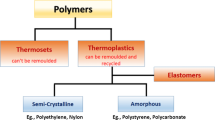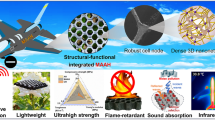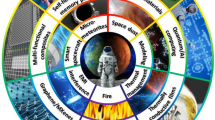Abstract
This study explains how the addition of a metallic filler particle along with various stacking ordered electromagnetic wave–suppressing fabrics influences the total electromagnetic interference shielding effectiveness at high frequency bands. The primary objective of this study was to develop a rigid non-flexible electromagnetic interference (EMI) shielding material for use in protecting electronic devices from electromagnetic interference. The fibre and silk fabric were stacked in resin as two different forms and copper slag particles are added in it. The composites were developed using the hand layup process and they were evaluated using the American Society for Testing and Materials (ASTM) standards. The conclusion states that the fibres staked in the aloe vera/silk/silk/aloe vera (RSA) sequence were found to have higher dielectric values. A highest dielectric constant of 5.68 was noted for the RSA2 composite. Similarly, the addition of silk fabric along with copper slag as A/S/S/A format found produced a highest EMI shielding of −54.8 dB at 20-GHz frequency. Moreover, the composite designation RSA2 produced improved mechanical properties and hardness. These EMI shielding–improved mechanically toughened epoxy-based composites could be used in defence, telecommunication sector, and radar and radome applications.





Similar content being viewed by others
References
M. Wang et al., Construction, mechanism and prospective of conductive polymer composites with multiple interfaces for electromagnetic interference shielding: a review. Carbon. 177, 377–402 (2021)
Y.J. Tan et al., Compos.-A: Appl. Sci. Manuf. 137, 106008 (2020)
H. Alshahrani, V.R. Arun, Prakash., Ind. Crops. Prod. 191, 115967 (2023)
L. Lyu et al., Eng. Sci. 2(59), 26–42 (2018). https://doi.org/10.30919/es8d615
T. Merizgui et al., Journal of Magnetism and Magnetic Materials 536, 168118 (2021)
X.H. Tang et al., Compos. B. Eng. 196, 108121 (2020)
Y. Zhang, J. Gu, Nano-Micro. Lett. 14, 89 (2022). https://doi.org/10.1007/s40820-022-00843-3
Y. Yao, S. Jin, H. Zou, et al., J. Mater. Sci. 56, 6549–6580 (2021). https://doi.org/10.1007/s10853-020-05635-x
C. Liang, Z. Gu, Y. Zhang, et al., Nano-Micro. Lett. 13, 181 (2021). https://doi.org/10.1007/s40820-021-00707-2
V. Antony Vincent et al., Trans. Electr. Electron. Mater., 1–9 (2021)
M.J. Prabhahar et al., Mater. Res. Express. 7(1), 016106
A. Vincent et al., Colloids. Interface. Sci. Commun. 24, 89–92
T.C. Phiri et al., Miner. Eng. 172, 107150
H. Tian et al., Resour. Conserv. Recycl. 168, 105366
T.C. Phiri et al., Miner. Eng. 180, 107474
R. Babu, A. Bonige, B. Rao, Biomass. Convers. Biorefin., 1–7 (2023)
G. Logesh et al., Ceram. Int. 49(2), 1922–1931 (2023)
Y. Fan, REWAS 2019: Manufacturing the Circular Materials Economy (Springer International Publishing, 2019), pp. 229–233
M. Fan et al., Chem. Eng. J. 441, 136103 (2022)
G. Yin et al., Colloids Surf. A: Physicochem. Eng. Asp 601, 125047 (2020)
D. Li et al., Compos.-A: Appl. Sci. Manuf. 141, 106237 (2021)
B. Yan et al., Int. J. Biol. Macromol. 226, 1141–1153 (2023)
H.Y. Wang et al., Int. J. Biol. Macromol. 143, 594–601
Liu et al., Adv. Funct. Mater. 29(44), 1905197 (2019)
Z. Xu et al., Compos.-A: Appl. Sci. Manuf. 119, 111–118 (2019)
Moonlek et al., Polym. Compos. 41(10), 3996–4009 (2020)
V.A. Prakash, R. Viswanthan, Compos.-A: Appl. Sci. Manuf. 118, 317–326 (2019)
J. Ben Samuel et al., Silicon. 13(6), 1703–1712 (2021)
V.R. Arun Prakash et al., Biomass. Convers. Biorefin. 12(12), 5451–5461 (2022)
H. Alshahrani, V.A. Prakash, Biomass. Convers. Biorefin., 1–9 (2022)
A. Rajadurai, Appl. Surf. Sci. 384, 99–106 (2016)
H. Alshahrani et al., J. Ind. Text. 52, 15280837221137382
V.A. Prakash, A. Rajadurai, Digest J. Nanomater. Biostruct. 11(2), 373–380 (2016)
L. Sun et al., Adv. Funct. Mater. 31(35), 2100280 (2021)
P. Xie et al., Adv. Compos. Hybrid. Mater. 5(2), 679–695 (2022)
Wang, Y., et al, Appl. Math. Model., 101, 239-258.
V. Rathi, V. Panwar, IEEE Trans. Electromagn. Compat. 60(6), 1795–1801 (2018)
J. Jyoti, A.K. Arya, Polym. Test. 91, 106839 (2020)
K.M. Batoo et al., Ceram. Int. 48(3), 3328–3343 (2022)
V.R. Arun Prakash, A. Rajadurai, Appl. Phys. A 122, 1–9 (2016)
D. Jayabalakrishnan et al., Silicon. 13(8), 2509–2517 (2021)
G. Suganya et al., Biomass. Conv. Bioref. (2022). https://doi.org/10.1007/s13399-022-02787-5
M. Bourchak et al., J. Vinyl Addit. Technol. (2023). https://doi.org/10.1002/vnl.21990
Author information
Authors and Affiliations
Contributions
All the authors equally contributed.
Corresponding author
Ethics declarations
Code of ethics
NA.
Conflict of interest
The authors declare no competing interests.
Rights and permissions
Springer Nature or its licensor (e.g. a society or other partner) holds exclusive rights to this article under a publishing agreement with the author(s) or other rightsholder(s); author self-archiving of the accepted manuscript version of this article is solely governed by the terms of such publishing agreement and applicable law.
About this article
Cite this article
Ramesh Babu, B., Rao, B. Electromagnetic interference shielding behaviour of stacked aloe vera and silk fibre–reinforced high-content copper slag powder epoxy sandwich composite. emergent mater. 6, 1363–1370 (2023). https://doi.org/10.1007/s42247-023-00515-x
Received:
Accepted:
Published:
Issue Date:
DOI: https://doi.org/10.1007/s42247-023-00515-x




